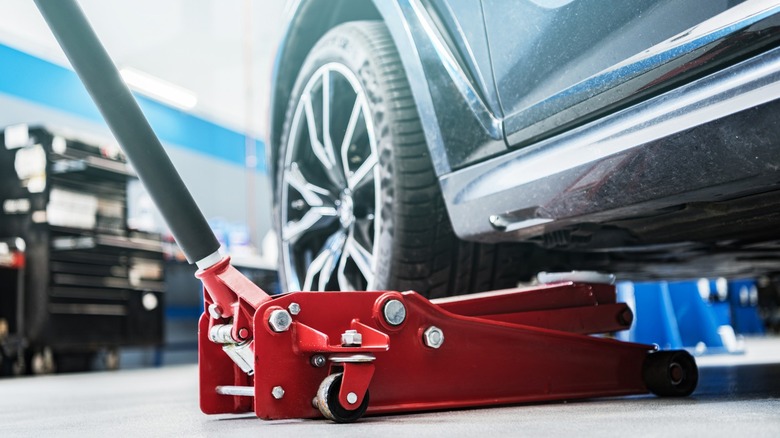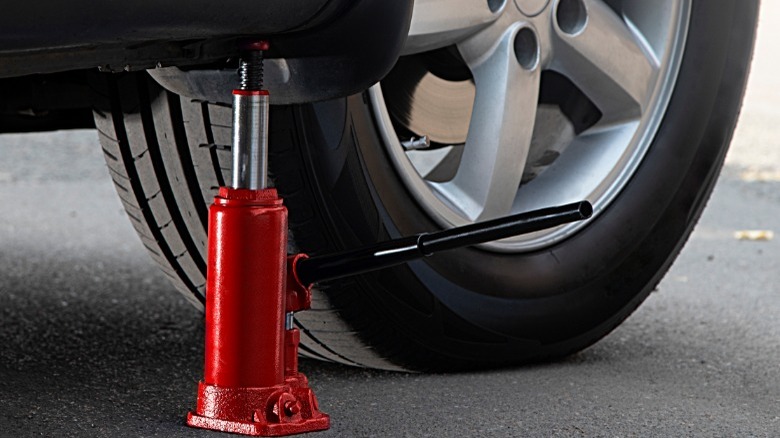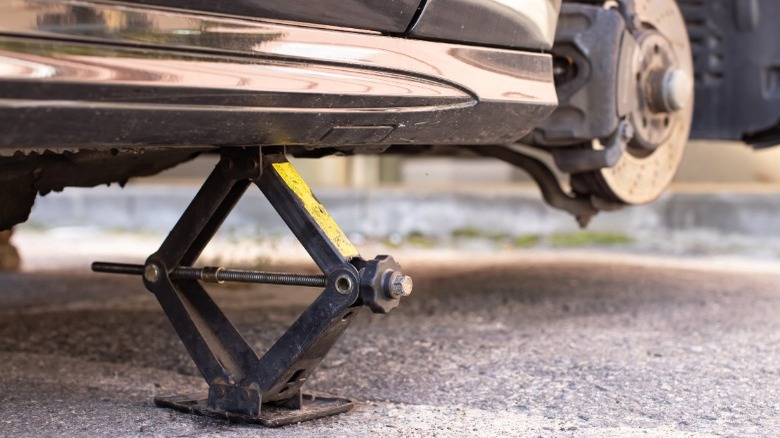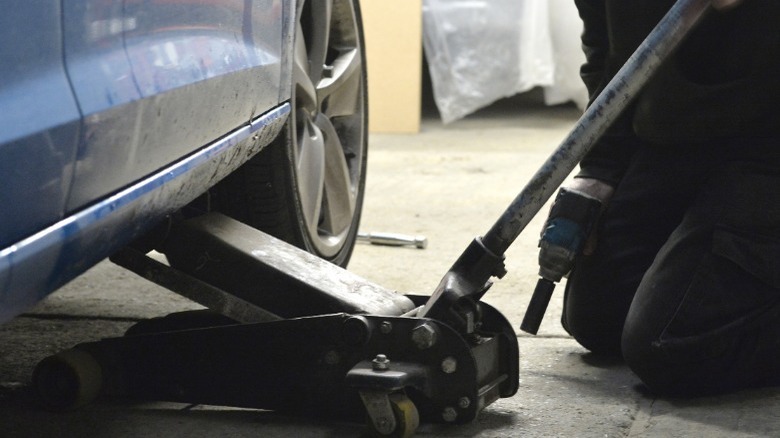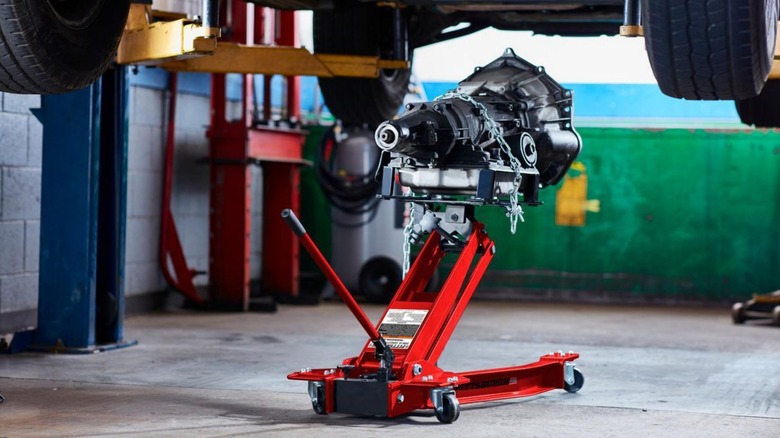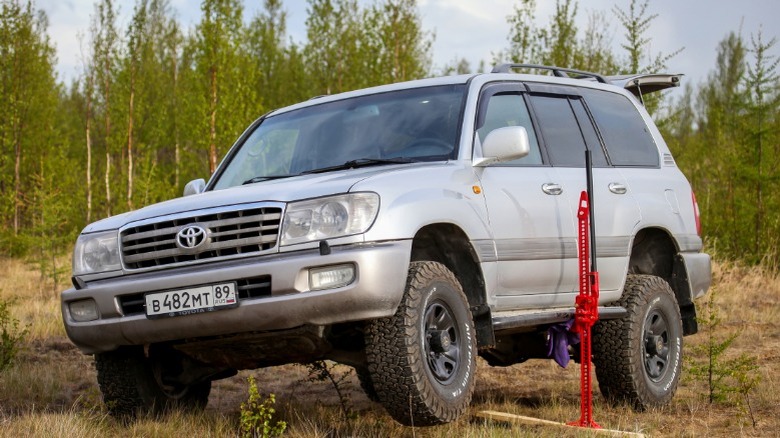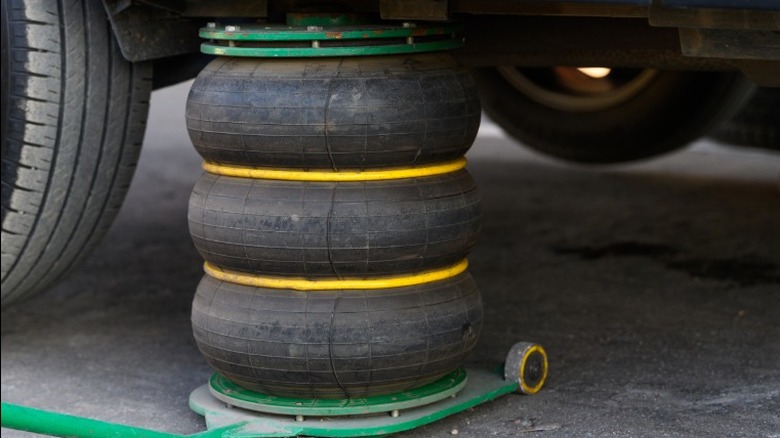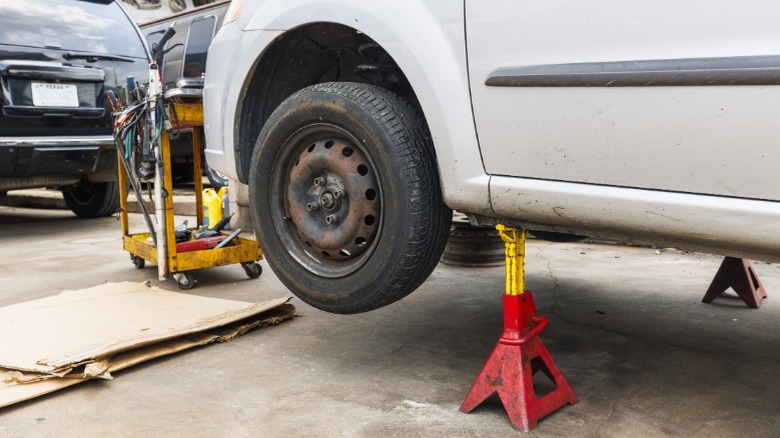6 Types Of Automotive Jacks (And When To Use Them)
Working on cars requires a vast assortment of different tools. From extremely common devices like impact wrenches, socket sets, and screwdrivers to specialty and niche tools like OBDII code readers, snap ring pliers, and feeler gauges, a mechanic's tool kit is extensive and always growing. Some tools, like jacks, are easy to overlook and take for granted. However, in reality, jacks are some of the most critical devices that both professional and home mechanics use.
You may be familiar with automotive jacks, thanks to the basic version that automakers often include with a car's spare tire and other emergency supplies. But did you know that there are actually various different types of automotive jacks, each with unique applications and uses? It's true — automotive jacks come in numerous different shapes and sizes. Some of the most common types that you're likely to encounter include scissor jacks, bottle jacks, and floor jacks.
However, various other kinds of automotive jacks exist, and if you're a mechanic or an avid DIYer, it's a good idea to familiarize yourself with these devices and their uses. As a former professional auto repair technician and a lifelong gearhead, I'll break down the most common types of automotive jacks and explain how and when to use each. We'll even go one step further and explore jack stands, a related yet distinct device with its own vital applications. So, from bottle jacks to farm jacks and more, here are six types of automotive jacks.
Bottle jacks
Bottle jacks represent one of the most common types of automotive jacks. As the name implies, bottle jacks tend to be compact and shaped like a fat glass bottle. You can buy bottle jacks in various sizes and weight capacities from numerous auto parts stores. However, it's also extremely common for a bottle jack to come with a new vehicle, especially larger vehicles like trucks and SUVs. If your car comes with a bottle jack, you'll most likely find it located with the spare tire and any other emergency supplies.
Bottle jacks work using hydraulic pressure, a piston, and some type of pumping mechanism. As the user operates the jack's pump, hydraulic pressure builds, which causes the piston to expand upwards and raise the lifting plate. Bottle jacks are sturdy and designed to lift heavier vehicles. However, they aren't ideal for extended projects or heavy-duty work. Bottle jacks typically have a narrow base, which can make them less stable than other jacks, and you should avoid lifting the entire car off the ground using them.
So, when should you use bottle jacks, and how do you operate them? Bottle jacks are ideal for quick work in emergency or unplanned situations. For example, if you end up with a flat tire on the side of the highway, a bottle jack can be an excellent and quick way to support one-quarter of the car while you change the flat. When it comes to using a bottle jack, most devices rely on a long handle to twist or push an internal pump to build hydraulic pressure. Bottle jacks usually don't extend or compress as rapidly as other devices, which is another reason they're less ideal for extensive work like brake jobs or engine repair.
Scissor jacks
Scissor jacks are another extremely common type of automotive jack. Like bottle jacks, automakers frequently include scissor jacks with spare tires and other emergency equipment when you buy a new car. However, unlike bottle jacks, scissor jacks are more ideal for smaller vehicles like sedans and other passenger cars. That's largely due to the fact that scissor jacks tend to have lower weight capacities and lifting ranges than bottle jacks and other automotive-lifting tools. Scissor jacks work thanks to four connected arms and a long screw.
The four arms connect to each other at pivot points and form a diamond. The bottom of the diamond connects to a wide base, while the top features a lifting plate. The screw attaches to the diamond via two holes on the sides. As you turn the screw, it pushes the two sides of the diamond together, causing the shape to narrow and the lifting plate to rise.
Like bottle jacks, scissor jacks are not the best tool for long jobs or tasks requiring you to lift the entire vehicle off the ground. Instead, these devices are ideal for rapid and easy work like replacing a flat tire or performing a quick oil change. To use a scissor jack, you must first position it beneath a safe lift point, like your car's pinch weld or frame rail. Then, connect the lever or handle to the round hole or nut on one side of the jack. Turning the lever will rotate the screw, which will cause the jack to extend and lift your vehicle.
Floor jacks
When it comes to automotive jacks, floor jacks are tough to beat. They're some of the most common jacks you're likely to encounter, both in professional shops and in-home mechanics' garages, and they provide an incredibly broad range of applications and uses. Floor jacks are available in a wide selection of weight capacities, from small compact devices to large, heavy-duty trolley jacks. Floor jacks are sometimes referred to as alligator jacks thanks to their long and narrow appearance and a lifting plate that can look similar to an alligator opening its mouth. They work using hydraulic pressure that the user builds by pumping a long handle. Most floor jacks have four heavy-duty wheels and are designed to roll underneath a vehicle and raise it off the ground via an appropriate lift point.
In contrast to bottle and scissor jacks, floor jacks are ideal for a wide range of automotive maintenance and repair work. Because floor jacks have a large base and tend to have high weight capacities, they work well for extended jobs and for lifting the vehicle from multiple points. For example, you can use a floor jack — with the appropriate weight rating — to lift the entire rear end of a truck or SUV by placing it under the rear differential. Alternatively, you can use two floor jacks to lift the entire front end. To use a floor jack, all you have to do is roll it under the car, position the support plate beneath an appropriate lift point, turn the handle to the right, and start pumping. When you're ready to lower the jack, slowly turn the handle to the left to release the hydraulic pressure.
Transmission jacks
Transmission jacks are less common than bottle, scissor, and floor jacks. However, they still see a lot of action in both pro shops and hobbyists' driveways, and they can be extremely useful when working with gearboxes and other large pieces of equipment. As the name implies, transmission jacks are designed to help install or remove transmissions. Many transmission jacks — specifically, roll-under jacks — look a lot like floor jacks and function in a similar way.
However, floor jacks and transmission jacks are not the same thing. In comparison to standard floor jacks, transmission jacks typically have lower weight capacities to accommodate passenger gearboxes, which usually weigh between 100 and 400 pounds. Some transmission jacks have heavier weight capacities and are designed for working on large trucks and commercial vehicles, which can have transmissions weighing upwards of 3,000 pounds. Besides generally having lower weight capacities, transmission jacks may also have larger support plates with built-in clamps and chains to secure gearboxes during removal or installation.
It may seem obvious, but transmission jacks are used primarily when installing or removing a car's gearbox. You may choose to use them for other tasks — for example, you could use a transmission jack to support an axle or rack and pinion gear. That said, these devices are designed chiefly for working with transmissions. To use a transmission jack, you first need to position it properly beneath the gearbox. Then, slowly and steadily begin pumping the jack to lift the transmission. Once the gearbox is free of its supports, secure it to the jack using the built-in clamps or chains, and then disconnect any remaining mounts holding the transmission in place.
Farm jacks
Farm jacks — sometimes called high-lift jacks or off-road jacks — represent another less well-known type of automotive jack. Nevertheless, these devices have some niche uses and are extremely common in certain applications. Specifically, farm jacks are a pretty common sight in the world of off-road driving. You may have seen those odd-looking devices strapped to the backs of jeeps and other all-terrain vehicles. They look somewhat like long metal beams with a series of holes running along the length.
Farm jacks also have a flat plate at the base, a lifting foot, and a long, thin handle or lever. They generally have substantial weight capacities and, depending on the type, can support several tons. Farm jacks are designed to lift significantly higher than standard devices like bottle, scissor, and floor jacks, with most having a height range between 42- and 60-inches. Farm jacks aren't as popular as things like floor jacks and bottle jacks. They're used primarily in off-road situations, like when a driver gets stuck crawling over some boulders, and in agricultural applications, like when ripping up old fence posts.
Farm jacks can be less safe and stable than other types of jacks, and you shouldn't lift a vehicle using one and then leave it unattended. Rather, using a farm jack typically requires you to have at least one hand on the tool at all times to keep it stable. You'll need to place the jack's bottom platform on the most solid and stable surface you can find. Then, flip the safety switch to allow the jack to expand. Position the jack's lifting foot, and start pumping the handle to raise your vehicle or any other object.
Air jacks
Air jacks — sometimes referred to as pneumatic jacks or airbag jacks — are another less common and less well-known type of automotive jack. It's uncommon to see air jacks in standard auto repair shops. However, they have their niche uses and applications and can be extremely handy in certain situations. Air jacks look very similar to the air struts or springs found in vehicles with adaptive suspension systems. They work using a heavy-duty inflatable sack. When you connect a supply of compressed air to the jack, that sack inflates, lifting whatever is positioned above it.
Air jacks are used primarily in heavy-duty applications. While you may not find them in normal auto garages, you're likely to see pneumatic jacks in commercial diesel repair shops, military garages, construction sites, as well as various other job sites and places where heavy-duty equipment is used, like farms and mines. Air jacks can be especially handy in situations in which one or two conditions are met: You need to lift an extremely heavy piece of equipment, and/or there is very little space to fit a standard jack.
That's because air jacks can have substantially greater weight capacities than normal jacks — in some cases, these devices can lift upwards of 70 tons. Air jacks can also compress down to a very small size, making them ideal for lifting extremely heavy pieces of equipment with very little ground clearance. To use an air jack, you'll need to position it on a solid surface beneath a safe lift point. Then, connect an air hose and turn the jack on. Different jacks may have different buttons and levers. However, the general steps should be relatively similar.
What about jack stands?
We've covered six different types of automotive jacks, including the three most common kinds and a few types that are less well-known. However, anytime we're talking about automotive jacks, it's a good idea to mention jack stands. Jack stands are safety devices that we use in conjunction with regular jacks. They have a wide base and extendable arms with support plates or cradles. The purpose of jack stands is to provide a secondary support system in case your jack fails.
You can also lift your vehicle using a standard jack, place four jack stands underneath it, and then remove the jack, allowing the jack stands to support the car independently. These devices are vital when performing extended repairs or any work that requires you to crawl under the vehicle. Because of their importance, it's critical that you buy quality jack stands that are capable of supporting your car's weight. You don't have to buy the most expensive products out there, but you should choose one built by a reputable brand and rated appropriately for your vehicle.
To use a jack stand, all you need to do is position it beneath a safe lift point, like a pinch weld or frame rail. Then, raise the support arm until it's almost touching the frame rail or pinch weld. Once your jack stand is in position, slowly release your floor, bottle, or scissor jack, allowing the car to settle down onto the jack stand. When you're ready to remove the jack stand, lift the vehicle back up using a standard jack, and then remove the stand.
